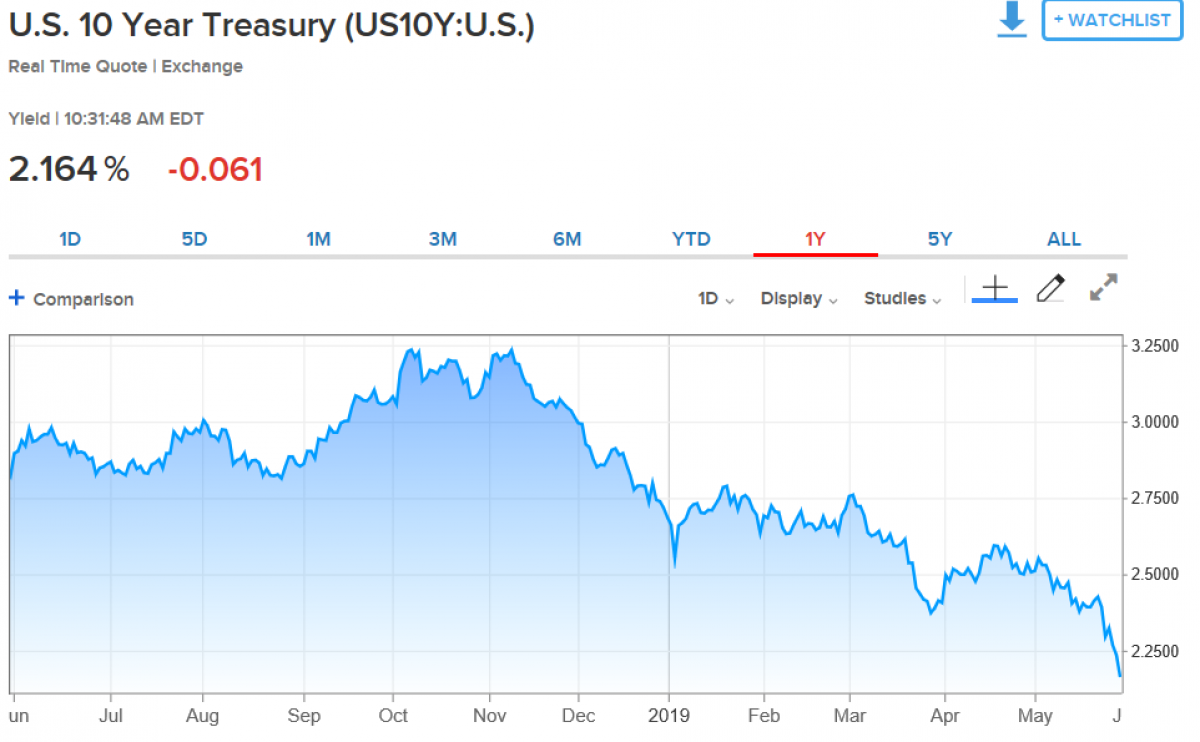Inversion is back in the news. Treasury yields have been falling dramatically over the last week or so, with yield on the 10-Year Treasury Note falling to below 2.2% for the first time since the middle of 2017. Given that the Fed has raised short-term rates significantly since then, that has resulted in longer-term yields falling below those on short-term debt, giving an inverted yield curve. That is typically taken as a sign of upcoming economic weakness in the U.S. and even of an impending recession, but what does it mean for energy investors?
(Click to enlarge)
The most obvious implications are bad. If the market is correct and we are heading towards recession in the U.S., that would have a significant effect on oil demand, pushing prices ever lower. That, in turn, will add to the downward pressure on oil stocks and energy stocks in general.
Nor is the broader picture looking good for oil prices. Yesterday’s tweet from President Trump announcing tariffs on Mexico has reinforced the view that he believes in the power of tariffs to advance a multitude of policy positions, even those not directly related to trade and economics. For a commodity such as oil, where global growth expectations play such an important role in pricing, that is a very bearish sign and will add to the pressure on energy stocks.
Even as all that happens, though, the very low yields on Treasuries and other fixed income securities may well put a floor on stocks of integrated,…
Inversion is back in the news. Treasury yields have been falling dramatically over the last week or so, with yield on the 10-Year Treasury Note falling to below 2.2% for the first time since the middle of 2017. Given that the Fed has raised short-term rates significantly since then, that has resulted in longer-term yields falling below those on short-term debt, giving an inverted yield curve. That is typically taken as a sign of upcoming economic weakness in the U.S. and even of an impending recession, but what does it mean for energy investors?

(Click to enlarge)
The most obvious implications are bad. If the market is correct and we are heading towards recession in the U.S., that would have a significant effect on oil demand, pushing prices ever lower. That, in turn, will add to the downward pressure on oil stocks and energy stocks in general.
Nor is the broader picture looking good for oil prices. Yesterday’s tweet from President Trump announcing tariffs on Mexico has reinforced the view that he believes in the power of tariffs to advance a multitude of policy positions, even those not directly related to trade and economics. For a commodity such as oil, where global growth expectations play such an important role in pricing, that is a very bearish sign and will add to the pressure on energy stocks.
Even as all that happens, though, the very low yields on Treasuries and other fixed income securities may well put a floor on stocks of integrated, big oil companies.
Since the recession in 2008/9, the role of those stocks as income producers has been significantly downplayed. A combination of a rising rate environment and uncertainty about the long-term trajectory of oil prices has engendered doubts about the ability of big oil to continue to pay good dividends, or at least to continue to grow their dividend payouts.
The fact is though that both Chevron (CVX) and Exxon Mobil (XOM) have still increased their annual payouts every year since 2008 with only one exception, when CVX paid out the same amount in 2015 as in 2014. That still hasn’t been enough for investors though, with both CVX and XOM massively underperforming the broader market over the last decade.
The current interest rate environment could well see that underperformance come to an end.
As interest rates on bonds fall, so a dividend payment, particularly one with a proven record of growing, becomes more and more valuable. The questions for investors are whether that implied value from dividends will be enough to offset the effects of falling oil prices, and how far those prices can fall.
To some extent, the answer to the first question depends on the answer to the second, and that depends on how you view the president’s actions.
After being in denial for the first year or two following Trump’s election, markets in general now seem to be accounting for the possible damage to the U.S. and global economies of a trade war. When assessing the long-term impact of those trade policies it is important to consider the political dynamic, and that suggests that a resolution will be found.
Trump’s supporters have so far kept the faith, with even farmers directly hurt by the tariffs often saying that they still supported the long-term goals of better trading conditions. If, however, the stock market continues to fall as the next election draws closer, that faith will be tested. Say what you will about Donald Trump, he has shown a remarkable ability to read the feelings of his base, even when that means defying conventional wisdom, and most of his actions can be explained by the desire to keep them onside. As cynical as it sounds, that, rather than any long-term interest, is likely to be the driving force behind trade negotiations from here, so a deal of some kind must be likely.
On that basis, while oil can certainly continue to drop from here for a while, a complete collapse doesn’t look to be on the cards.
That will be enough to enable companies like Chevron and Exxon Mobil to continue to raise their dividend and in a falling interest rate environment, that makes them doubly attractive.
So, as worrying as the sharp drop in Treasury yields is for investors in general, it may not be a bad thing for those who focus on energy, and especially for those interested in big oil stocks. Splitting an investment between those two names offers a yield that is nearly double that garnered from 10-Year Treasuries and may be a smart move at these levels.
















